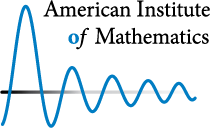2. Algebraic Statistics and Tensor Characterizations
-
Can we characterize tensors of non-negative rank at most 3 using the description of $RBM_{3,2}?$
Recently it has been shown that $RBM_{3,2} = {\cal M}_{3,3},$ where up to scaling, ${\cal M}_{3,3}$ is the set of tensors of non-negative rank at most 3, i.e. ${\cal M_{3,3}} = \{p \in \mathbb{R}^8 : p = \sum_{i=1}^3 a_i \otimes b_i \otimes c_i, \text{ where } a_i,b_i,c_i \in \mathbb{R}^2_{\geq 0} \text{ for } i=1,2,3 \}.$Problem 2.1.
[org.aimpl.user:tmerkh@g.ucla.edu] Is it possible to use the implicit description of $RBM_{3,2}$ to determine the characterizing properties of non-negative rank $\leq 3$ tensors?
Could this recent finding be used to determine a non-negative rank 3 generalization of the supermodularity and flattening rank constraints known for non-negative rank $\leq 2$ tensors? $$ $$ See $$ $$ Seigal, Anna, and Guido Montufar. "Mixtures and products in two graphical models." arXiv preprint arXiv:1709.05276 (2017).$$ $$ and $$ $$ Allman, Elizabeth S., et al. "Tensors of nonnegative rank two." Linear algebra and its applications 473 (2015): 37-53. -
What are the algebraic structures relevant for studying learning algorithms for RBMs?
Problem 2.2.
[Anna Seigal] What are the algebraic structures relevant for studying learning algorithms for RBMs?
Cite this as: AimPL: Boltzmann Machines, available at http://aimpl.org/boltzmann.
